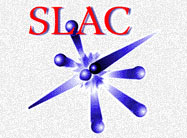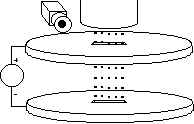 |
Search For Isolated Fractionally Charged Particles |  |
 |
Search For Isolated Fractionally Charged Particles |  |
Experimental Apparatus
The fractional charge search apparatus utilizes Robert Millikan's technique of measuring the terminal velocity of a drop falling in air under two different values of electric field to obtain its mass and electric charge. We have improved upon this basic technique by:
- Utilizing electronic CCD imaging and concurrent on-line computer analysis to obtain the value of the electric charges in real time.
- Generating controlled arrays of uniform falling drops with micromachined fluid ejectors.
- Utilizing controlled laminar air flow to adjust the fall speed of the drops to optimize measurement accuracy.
The data acquisition and analysis hardware of the second and third fractional charge search experiments utilize networked computer technology. High speed Ethernet connections between multiple Linux PCs allow simultaneous real time image acquisition, extraction of charge data, statistical analysis and data archiving. Real time raw data can be monitored over the Internet. Data is current being acquired at a rate of 5 Gigabytes per week and are archived on optical disks.
The image acquisition utilizes a high end digital monochrome CCD camera interfaced to the computer with a scientific grade PCI bus frame grabber card.
The first fractional charge search experiment run at SLAC. Operated under DOS using a 66 MHz 486 and a VESA bus frame grabber to acquire the images.
The experiment is ran between 1994-1995.
Measurement accuracy achieved is better than 1/40e.
Mass throughput was 1.07 grams of oil (6 million drops).
The fractional charge search experiment measurement chamber and optical hardware for the multiple drop array measurement experiments. The experiment is small enough that it could be constructed on a 6 foot by 4 foot optical table. The drop ejector and electric field plates are located in a triple enclosed measurement chamber with transparent walls.
The apparatus was constructed and operated between 1996-1999.
Measurement accuracy achieved is better than 1/50e for 10 micron diameter drops.
Mass throughput was 17.4 grams of oil (40 million drops).
The fractional charge search experiment measurement chamber and optical hardware for the horizontal e-field, laminar air flow, charge measurement apparatus. The experiment ran from 2000 - 2001.
Charge measurement accuracy achieved was better than 1/50e for drops of up to 20 microns in diameter.
Mass throughput was 70.1 milligrams of oil (17 million drops).
The final fractional charge search experiment utilized a powdered meteorite in oil suspension as the test material. The apparatus is configured as a horizontal e-field, upwards laminar air flow, Millikan charge measurement apparatus. Machine vision mediated auto-control of: the average charges of the drops, the fall path of the drops, the upward laminar air flow, and the electronic drive to the drop ejector are new features of this fluid drop charge measurement system.
The experiment is ran from 2004 - 2007.
Charge measurement accuracy achieved is better than 1/24 e for drops of up to 26 microns in diameter.
Mass throughput was 262.8 milligrams of meteorite in oil
suspension (42 million drops).
The meteorite mass fraction in the suspension was 1.5 percent
by weight.
[SLAC home] [MPS home] [Hist] [Phys] [FCMat] [Apparat] [TestMat] [Microdrop] [Results] [Team] [Refs]
[MPSPhys] [MSPAppat] [MPSRefs]
April 30, 2007
Stanford Linear Accelerator Center
Website maintenance: erlee@SLAC.stanford.edu